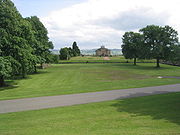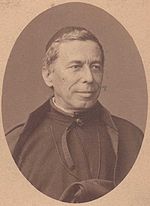
Stonyhurst Observatory
Encyclopedia
The Stonyhurst Observatory is a functioning observatory and weather station
at Stonyhurst College
in Lancashire
, England. Built in 1866, it replaced a nearby earlier building, built in 1838, which is now used as the Typographia Collegii.
The records of temperature, which continue to be taken taken there, began in 1846 and are the oldest continuous daily records in the world. In 2004, Stonyhurst replaced Ringway as one of four weather stations used by the Met Office
to provide central England temperature data (CET); revised urban warming and bias adjustments have since been applied to the Stonyhurst data.
During the course of the twentieth century, the observatory fell out of use for astronomical purposes and its telescope, parts of which dated to the 1860s, was sold after the Second World War. When its private owner came to re-sell it, the College was able to buy it back and restore it to its original home. See: Stonyhurst Refractor
The observatory is currently run by Classics master Fintan O' Reilly, who also teaches GCSE astronomy. Occasionally access is permitted to the observatory for visitors.
 The observatory was originally established at Stonyhurst College
The observatory was originally established at Stonyhurst College
in 1838, and intended primarily to serve as a meteorological station. With the foundation of the Meteorological Office in 1854, it became one of seven key UK stations. The observatory was managed and operated by the Jesuit priests who ran the school. During the mid-nineteenth century, Fathers Weld, Perry
and Sidgreaves, broadened the scope of the observatory's operations to include astronomy, geomagnetrometry and seismology.
In 1858, the observatory was chosen as one of the main observing stations by General Sir Edward Sabine
, when he was conducting a magnetic survey of England. Five years later, the observatory's first regular series of monthly geomagnetic observations was inaugurated by Fr Sidgreaves. In 1866, the latter installed a set of self-recording photographic magnetographs, donated by the Royal Society, in a specially constructed underground chamber.
Sidgreaves also carried out original research into the solar spectrum, contained in many papers published in the Monthly Notices of the Royal Astronomical Society. In solar physics he made a long photographic study of the sun, including hundreds of photographs taken in the violet light of calcium, using a Hilger spectroscope acquired by Father Perry
. In this research he showed that the sun is spectroscopically, a variable star.
During his time as president of the Branch, Sidegreaves carried out original work into the spectroscopy of novae. His work on Nova Aurigae, in 1892, contained some of the first photographs of the spectra of novae ever taken. He recognised in them the similarity between the spectrum of the new star and that of the solar chromosphere, rich in the pink light of ionised hydrogen. Equally significant results were obtained with the spectrum of Nova Perseii, in 1901.
 Sidgreaves was particularly interested in the connection between sunspots and fluctuations in earth's magnetic field. He published several papers on the subject based on observations made at Stonyhurst. In work carried out between 1881 and 1898, he came to the conclusion that although magnetic storms were not directly a result of sunspots, they were due to clouds of electrified particles moving between the sun and earth. We now know that solar mass ejections caused by solar flares can interact with the Earth's magnetic field to produce magnetic storms. They are now of great importance, having been known to disrupt national power-grids and cause expensive damage earth-orbiting telecommunication satellites.
Sidgreaves was particularly interested in the connection between sunspots and fluctuations in earth's magnetic field. He published several papers on the subject based on observations made at Stonyhurst. In work carried out between 1881 and 1898, he came to the conclusion that although magnetic storms were not directly a result of sunspots, they were due to clouds of electrified particles moving between the sun and earth. We now know that solar mass ejections caused by solar flares can interact with the Earth's magnetic field to produce magnetic storms. They are now of great importance, having been known to disrupt national power-grids and cause expensive damage earth-orbiting telecommunication satellites.
In 1848, the year in which Sidgreaves first attended the College
, the Italian astronomer, Father Angelo Secchi
, of the Jesuit Collegio di Romano Observatory, in Rome, had stayed at Stonyhurst
, in retreat from revolutionary troubles in Italy. Stonyhust's
astronomical leanings, particularly in solar observation, apparently stemmed from his time in residence.
where they were devised in the nineteenth century.
Weather station
A weather station is a facility, either on land or sea, with instruments and equipment for observing atmospheric conditions to provide information for weather forecasts and to study the weather and climate. The measurements taken include temperature, barometric pressure, humidity, wind speed, wind...
at Stonyhurst College
Stonyhurst College
Stonyhurst College is a Roman Catholic independent school, adhering to the Jesuit tradition. It is located on the Stonyhurst Estate near the village of Hurst Green in the Ribble Valley area of Lancashire, England, and occupies a Grade I listed building...
in Lancashire
Lancashire
Lancashire is a non-metropolitan county of historic origin in the North West of England. It takes its name from the city of Lancaster, and is sometimes known as the County of Lancaster. Although Lancaster is still considered to be the county town, Lancashire County Council is based in Preston...
, England. Built in 1866, it replaced a nearby earlier building, built in 1838, which is now used as the Typographia Collegii.
The records of temperature, which continue to be taken taken there, began in 1846 and are the oldest continuous daily records in the world. In 2004, Stonyhurst replaced Ringway as one of four weather stations used by the Met Office
Met Office
The Met Office , is the United Kingdom's national weather service, and a trading fund of the Department for Business, Innovation and Skills...
to provide central England temperature data (CET); revised urban warming and bias adjustments have since been applied to the Stonyhurst data.
During the course of the twentieth century, the observatory fell out of use for astronomical purposes and its telescope, parts of which dated to the 1860s, was sold after the Second World War. When its private owner came to re-sell it, the College was able to buy it back and restore it to its original home. See: Stonyhurst Refractor
The observatory is currently run by Classics master Fintan O' Reilly, who also teaches GCSE astronomy. Occasionally access is permitted to the observatory for visitors.
History

Stonyhurst College
Stonyhurst College is a Roman Catholic independent school, adhering to the Jesuit tradition. It is located on the Stonyhurst Estate near the village of Hurst Green in the Ribble Valley area of Lancashire, England, and occupies a Grade I listed building...
in 1838, and intended primarily to serve as a meteorological station. With the foundation of the Meteorological Office in 1854, it became one of seven key UK stations. The observatory was managed and operated by the Jesuit priests who ran the school. During the mid-nineteenth century, Fathers Weld, Perry
Stephen Joseph Perry
Stephen Joseph Perry was an English Jesuit, known as a participant in scientific expeditions.-Life:...
and Sidgreaves, broadened the scope of the observatory's operations to include astronomy, geomagnetrometry and seismology.
In 1858, the observatory was chosen as one of the main observing stations by General Sir Edward Sabine
Edward Sabine
General Sir Edward Sabine KCB FRS was an Irish astronomer, geophysicist, ornithologist and explorer.Two branches of Sabine's work in particular deserve very high credit: Determination of the length of the seconds pendulum, a simple pendulum whose time period on the surface of the Earth is two...
, when he was conducting a magnetic survey of England. Five years later, the observatory's first regular series of monthly geomagnetic observations was inaugurated by Fr Sidgreaves. In 1866, the latter installed a set of self-recording photographic magnetographs, donated by the Royal Society, in a specially constructed underground chamber.
Sidgreaves also carried out original research into the solar spectrum, contained in many papers published in the Monthly Notices of the Royal Astronomical Society. In solar physics he made a long photographic study of the sun, including hundreds of photographs taken in the violet light of calcium, using a Hilger spectroscope acquired by Father Perry
Stephen Joseph Perry
Stephen Joseph Perry was an English Jesuit, known as a participant in scientific expeditions.-Life:...
. In this research he showed that the sun is spectroscopically, a variable star.
During his time as president of the Branch, Sidegreaves carried out original work into the spectroscopy of novae. His work on Nova Aurigae, in 1892, contained some of the first photographs of the spectra of novae ever taken. He recognised in them the similarity between the spectrum of the new star and that of the solar chromosphere, rich in the pink light of ionised hydrogen. Equally significant results were obtained with the spectrum of Nova Perseii, in 1901.

In 1848, the year in which Sidgreaves first attended the College
Stonyhurst College
Stonyhurst College is a Roman Catholic independent school, adhering to the Jesuit tradition. It is located on the Stonyhurst Estate near the village of Hurst Green in the Ribble Valley area of Lancashire, England, and occupies a Grade I listed building...
, the Italian astronomer, Father Angelo Secchi
Angelo Secchi
-External links:...
, of the Jesuit Collegio di Romano Observatory, in Rome, had stayed at Stonyhurst
Stonyhurst
Stonyhurst is the name of a rural estate owned by the Society of Jesus near Clitheroe in Lancashire, England. It is dominated by Stonyhurst College, its preparatory school Stonyhurst Saint Mary's Hall and the parish Church of St Peter's.-The Estate:...
, in retreat from revolutionary troubles in Italy. Stonyhust's
Stonyhurst
Stonyhurst is the name of a rural estate owned by the Society of Jesus near Clitheroe in Lancashire, England. It is dominated by Stonyhurst College, its preparatory school Stonyhurst Saint Mary's Hall and the parish Church of St Peter's.-The Estate:...
astronomical leanings, particularly in solar observation, apparently stemmed from his time in residence.
Stonyhurst heliographic coordinates
The 'Stonyhurst System of heliographic coordinates' is one of two 'heliographic coordinate' systems used for identifying the position of features on the Sun's surface. In the Stonyhurst system the zero point is set at the intersection of the Sun's equator and central meridian as seen from the Earth. Longitude increases towards the Sun's western limb. A solar feature will have a fixed latitude as it rotates across the solar disk, but its longitude will increase. This is in contrast to the Carrington heliographic coordinate system, where the longitude remains approximately fixed in time. The coordinates take their name from the CollegeStonyhurst College
Stonyhurst College is a Roman Catholic independent school, adhering to the Jesuit tradition. It is located on the Stonyhurst Estate near the village of Hurst Green in the Ribble Valley area of Lancashire, England, and occupies a Grade I listed building...
where they were devised in the nineteenth century.
Stonyhurst disks
A 'Stonyhurst disk' is used to determine the longitude and latitude of sunspots. The Earth doesn't orbit precisely around the Sun's equator, so through the year the center of solar pictures moves up and down a little more than 7 degrees. This angle varies sinusoidally through the year and is called B0. Earth crosses the Sun's equator about December 7 and June 7 each year. This means that the lines of latitude on the sun do not appear as lines from the earth, but as elliptical arcs. Sunspots and other features will rotate across the face of the sun along lines of latitude. Stonyhurst disks are transparent overlays that match the size of whole-disk images of the sun. These disks provide a graphic means of locating sunspots on the solar disk in reference to lines of latitude and longitude. Different disk overlays are produced for different dates.Further reading
- Muir, T.E. (2006) Stonyhurst, (St Omers Press, Gloucestershire) second edition ISBN 0-9553592-0-1

